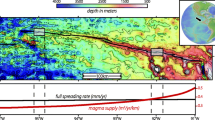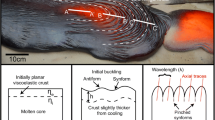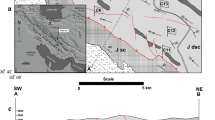Abstract
Shape-preferred orientation and imbrication structures of crystals have been measured on samples representative of the base, centre and top of a highly viscous lava flow on Salina (Aeolian Islands, southern Tyrrhenian Sea). The data allow zones with different deformation patterns to be identified. In the base and top of the flow, deformation leads to the development of discrete preferred orientation and imbrication of the elongate crystals. The sense of shear is right-lateral at the base and left-lateral at the top of the flow. Shear strain can be estimated by the analysis of crystal preferred orientation. Deformation increases from the flow centre to the outer, more viscous boundary layers. Random orientation of crystals in the inner zone supports the presence of plug flow in a pseudoplastic lava. The textural features of the studied lava may be related to different mechanisms (i.e. lateral expansion). We conclude that the observed crystal alignments and imbrication structures may be related to a plug flow moving between two non-deforming walls. The walls are represented by the solidified, broken upper and basal crust of the flow. The low shear strain values calculated in the outer margins of the flow are indicative of the last deformation event. Crystal preferred orientation and imbrication structures may be related to the occurrence of velocity gradients existing between the inner zone of the flow and its solidus or near-solidus outer margins.
Similar content being viewed by others
References
Barca D, Ventura G (1991) Volcano-tectonic evolution of Salina island (Aeolian Archipelago, South Tyrrhenian Sea). Mem Soc Geol It 47:401–415
Blanchard J Ph, Boyer P, Gagny C (1979) Un noveau critere de sense de mise en place dans une caisse filoniene: le “pincement” des mineraux aux epontes (orientation des mineraux dans un magma en ecoulement). Tectonophysics 53:1–25
Blumenfeld P (1983) Le “tuillage des megacristaux”, un critere d'ecullement rotationnel pour les fluidalites des roches magmatiques Application au Granite de Barbey-Seroux (Vosges, France). Bull Soc Geol Fr 7 (25):309–318
Blumenfeld P, Bouchez JL (1988) Shear criteria in Granite and migmatite deformed in the magmatic and solid states. J Struct Geol 10 (4):361–372
Colletta E (1993) Studio petrografico e geochimico della sequenza eruttiva del I Ciclo di attivita' del Mte dei Porri (Isola di Salina — Arcipelago delle Eolie). Thesis, University of Calabria, Italy
Den Tex E (1969) Origin of ultramafic rocks. Their tectonic setting and history. Tectonophysics 7:457–488
Ferguson CC (1979) Rotations of elongate rigid particles in slow non-Newtonian flows. Tectonophysics 60:247–262
Fernandez A, Laboue M (1983) Developement de l'orientation preferentielle de marqueurs rigides lors d'une deformation par aplattissement de revolution. Etude theorique et application aux structures de mise en place du granite de la Margeride au voisinage du bassin du Malzieu (Massif Central Francais). Bull Soc Geol Fr 7 (25):327–334
Fernandez A, Gasquet D (1994) Relative rheological evolution of chemically contrasted coeval magmas: example of the Tichka plutonic complex (Marocco). Contrib Mineral Petrol 116:316–326
Fernandez A, Feybesse JL, Mezure JF (1983) Theoretical and experimental study of fabrics developed by different shaped markers in two-dimensional simple shear. Bull Soc Geol Fr 7 (25):319–326
Jeffery GB (1922) The motion of elippsoidal particles immersed in a viscous fluid. Proc R Soc Lond A102:161–179
Johnson AM, Pollard DD (1973) Mechanics of growth of some laccolithic intrusions in the Henry Mountains, Utah. Field observations, Gilbert's model, physical properties and flow of the magma. Tectonophysics 18:261–309
Lacassin R, Leloup PH, Tapponier P (1993) Bounds on strain in large Tertiary shear zones of SE Asia from boudinage restoration. J Struct Geol 15 (6):677–692
Leal LG (1975) The slow motion of slender rod-like particles in a second order fluid. J Fluid Mech 69:305–337
March A (1932) Mathematische Theorie der Regelung nach der Corngestalt bei affiner Deformation. Z Kristallogr 81:285–297
Marsh BD (1981) On the crystallinity, probability of occurrence and rheology of lava and magma. Contr Mineral Petrol 78:85–98
Masuda T, Michiabayashi K, Ohta H (1995) Shape preferred orientation of rigid particles in a viscous matrix: re-evaluation to determine kinematic parameters of ductile deformation. J Struct Geol 17:115–129
Nye JF (1952) The mechanics of glaciers flow. J Glaciol 2 (12):82–93
Paterson WSB (1981) The physics of glaciers, 2nd edn. Pergamon Press, Oxford
Pinkerton H, Stevenson RJ (1992) Methods of determining the rheological properties of magmas at sub-liquidus temperatures. J Volcanol Geotherm Res 53:47–66
Ramsay JG, Huber MI (1983) The techniques of modern structural geology, vol 1. Strain analysis. Academic Press, London
Sanderson DJ (1977) The analysis of finite strain using lines with an initial random orientation. Tectonophysics 43:85–98
Shelley D (1985) Determining paleo-flow directions from ground-mass fabrics in the Lyttelton radial dykes, New Zealand. J Volcanol Geotherm Res 25:69–79
Smith JV, Yamauchi S, Miyake Y (1993) Microshear zones in a Miocene submarine dacite dome of southwest Japan. Bull Volcanol 55:438–442
Van den Driessche J, Brun JP (1987) Rolling structures at large shear strain. J Struct Geol 9 (5/6):691–704
Vernon RH (1987) A microstructural indicator of shear sense in volcanic rocks and its relationship to porphyroblast rotation in metamorphic rocks. J Geol 95:127–133
Wada Y (1992) Magma flow directions inferred from preferred orientations of phenocrysts in a composite feeder dyke, Miyake-Jima, Japan. J Volcanol Geotherm Res 49:119–126
Willis DG (1977) A kinematic model of preferred orientation. Bull Geol Soc Am 88:883–894
Author information
Authors and Affiliations
Rights and permissions
About this article
Cite this article
Ventura, G., De Rosa, R., Colletta, E. et al. Deformation patterns in a high-viscosity lava flow inferred from the crystal preferred orientation and imbrication structures: an example from Salina (Aeolian Islands, southern Tyrrhenian Sea, Italy). Bull Volcanol 57, 555–562 (1996). https://doi.org/10.1007/BF00304439
Received:
Accepted:
Issue Date:
DOI: https://doi.org/10.1007/BF00304439




